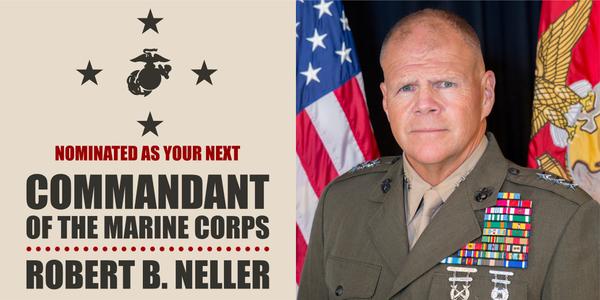
PENTAGON: Seven weeks ago, Defense Secretary Ashton Carter nominated a blunt-talking “soldier’s soldier” to be Army Chief of Staff, Gen. Mark Milley. Today, he announced a Marine’s Marine to be Commandant, Lt. Gen. Robert Neller. Bob Neller is celebrated for his direct, even blunt manner — but he’s also a military innovator on the cutting edge of new concepts of operations.
Carter made clear that what he valued most was Neller’s connection to the troops. The Carter-Neller connection doesn’t hurt either.
“I have known him since our work together when I was Deputy Secretary of Defense and he was director of operations, or J-3, on the Joint Staff,” Carter said at a Pentagon press conference this afternoon. “We collaborated in the Warfighter Senior Integration Group, where we focused on providing urgent support to our troops in the field, both in Iraq and Afghanistan.” The Warfighter SIG was a high-level body created in 2012 to accelerate rapid acquisition of counter-IED technology and other equipment, bypassing the regular procurement bureaucracy.
As part of that effort, Carter continued, “we traveled together, to theater and around this country, where I saw Bob’s outstanding relationship with our troops. He loves them, he relates to them, and they light up when he’s talking to them.”
Carter’s choice vaults Neller to a fourth star over the shoulders of the Marines’ current four-star generals. That includes Gen. John Kelly, the head of Southern Command (SOUTHCOM), and Assistant Commandant Gen. John Paxton, the No. 2 officer in the Corps, both of whom were rumored to be commandant candidates.
We heard a few days ago that Neller had climbed to the top of the list — and there he was today, flanked by Navy Secretary Ray Mabus and outgoing Commandant Gen. Joseph Dunford, who’s ascending to Chairman of the Joint Chiefs of Staff.

(L-R) Lt. Gen. Robert Neller, Navy Sec. Ray Mabus, and outgoing Commandant Gen. Joseph Dunford at the Pentagon for the announcement of Neller’s nomination.
Both Dunford and Neller still face confirmation hearings before the Senate — Dunford’s is on the 9th — although those are likely to be lovefests. Neller’s current job is as head of Marine Corps Forces Command (MARFORCOM), where he’s responsible both for providing forces for immediate missions and training them for future conflicts.
“It’s about speed. We’re in a post-Benghazi world,” Neller said at a Capitol Hill forum back in February. “The COCOMS [theater commanders] want us to be faster.”
That need for speed — on a tight budget with too few ships — requires the Marines to disperse and regroup their forces with an agility that traditional command-and-control structures cannot manage, Neller said. In last year’s Bold Alligator wargames, for example, instead of steadily building up a single Marine Air-Ground Task Force (MAGTF), the exercise commander rapidly threw units at problems under a decentralized structure. At the climax of the exercise, said Neller, “you have three separate Marine Air-Ground Task Forces — and that’s heresy.”
The new concepts also required creating new units, ranging from a literally flying headquarters called the Fly-In Command Element (FICE) to land-based, airmobile Special Purpose MAGTFs like those now stationed in Spain and the Mideast. They also require new kinds of communications network, like the Samsung tablets ad hoc’d in the back of V-22s by young Marines.
‘The world’s changed,” Neller told me after his public remarks. The “traditional” Marine Corps method was “load the ship, sail across the ocean, park off somewhere, and then project power ashore,” he said. Now we need options that are more agile for a more unpredictable and faster-moving planet.
“We know where our forces are,” Neller told me. “We don’t know where the crisis is” — until it hits.
For a look at where the current chairman of the Joint Chiefs believes the problems may be, you can look at the National Military Strategy released today.
Global military spending hits ‘all-time high’ of $2.4 trillion: SIPRI report
The US remains the world’s largest defense spender, outlaying $916 billion last year, a 2.3 percent annual increase, ahead of China in second place, which spent an estimated $296 billion, a 6 percent increase over the same period.



























